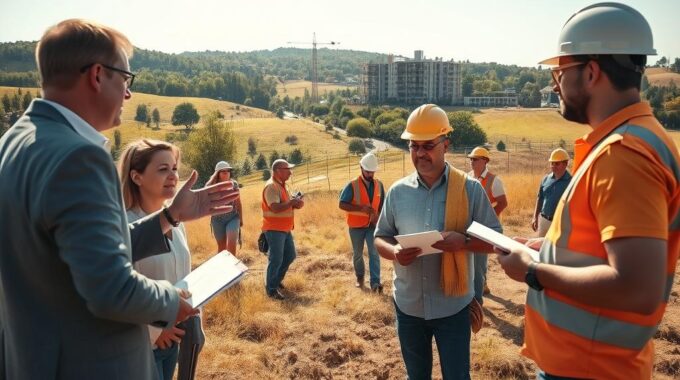Get a private-loan-in-costa-rica with GAP Equity Loans. Use your Costa Rican property as collateral for loans from $50,000 to $1,000,000.

Requesting a Loan? Don’t Forget the Site Visit
Did you know that nearly 20% of loan applications are delayed or rejected due to incomplete or inaccurate property information? When applying for a property-backed loan in Costa Rica, a site visit is a crucial step that can make or break your loan approval.
At Costa Rica Home Equity Loans, we connect borrowers with private investors and lenders, offering competitive rates and flexible financing options. Our experience shows that understanding the site visit process is essential for a smooth loan application.
To learn more about the site visit process and how to prepare for it, visit our detailed guide on site visits. By being prepared, you can improve your chances of loan approval and potentially secure better terms.
Understanding Home Equity Loans in Costa Rica
Leveraging your property’s equity is made possible through home equity loans in Costa Rica, offering a pathway to significant funding. Home equity loans in Costa Rica function as a financial tool that allows property owners to leverage the value of their real estate to secure funding for various purposes.
How Property-Backed Loans Work in Costa Rica
The loan process typically begins with an application where you provide information about your property and financial situation, followed by verification steps, including the crucial site visit. Unlike traditional loans that focus primarily on income verification, property-backed loans work by using your real estate as collateral, making them accessible to a wider range of borrowers, including foreign investors.
Benefits of Using Your Property as Collateral
Costa Rican property-backed loans offer a practical way to access money without selling your property, allowing you to tap into your equity while maintaining ownership. The collateral-based nature of these loans often results in more competitive interest rates and flexible terms compared to unsecured loans, making them attractive for property owners. Foreign investors particularly benefit from these loans as they may face challenges qualifying for traditional financing in Costa Ric,a but can leverage their property assets.
Understanding the local property market, legal requirements, and valuation process is essential before applying for a home equity loan in Costa Rica. Private lenders and investors often fill the gap where traditional banks may be reluctant to lend, offering more personalized loan structures tailored to the unique aspects of Costa Rican properties.
The Importance of a Site Visit When Requesting a Loan
The site visit is a critical component of the loan application process that lenders use to assess risk. As banking professionals, our primary goal is to minimize risk for our bank, and regular site visits to loan properties are among the top practices we employ to achieve this.
Why Lenders Require Property Inspections
Lenders require property inspections to confirm that the collateral actually exists, is in the condition represented, and matches all provided documentation before committing to lending against it. During the site visit, professionals assess numerous factors, including property location, construction quality, access, neighboring properties, and potential environmental concerns that could affect the property’s value.
For Costa Rican properties, site visits are particularly important due to the country’s diverse topography, varying microclimates, and sometimes informal construction practices that may not be evident in documentation. This firsthand verification is crucial for lenders to ensure that their investment is secure.
How Site Visits Reduce Risk and Protect All Parties
Site visits represent a critical risk management tool for lenders, providing firsthand verification that cannot be achieved through documentation alone. By conducting site visits, lenders can identify potential legal issues such as boundary disputes, encroachments, or unauthorized construction that could jeopardize the property’s value and the security of the loan.
From a risk perspective, the inspection helps establish an accurate loan-to-value ratio, ensuring the lender isn’t overexposed and the borrower isn’t overleveraged. While site visits require time and resources, they ultimately save both parties from potential complications and financial losses that could arise from lending against problematic properties.
What Happens During a Property Site Visit?
When applying for a loan in Costa Rica, a crucial step often involves a site visit to verify the property being used as collateral. This visit is a critical component of the loan application process, as it allows lenders to assess the property’s value, condition, and suitability as collateral.
The Step-by-Step Inspection Process
The on-site verification process typically involves several key steps. First, the lender schedules a visit to the property once the loan application has passed the initial stages. During the visit, a thorough inspection of the property is conducted by the lender’s representative or a third-party agency.
The inspection includes a comprehensive assessment of both the exterior and interior of the property. The evaluator takes detailed notes and photographs to document the property’s condition and features, verifying property boundaries and measuring the actual dimensions to confirm they match the legal description in the documentation.
- The inspection process includes verification of property boundaries and measuring the actual dimensions of the property.
- Evaluators assess structural elements, construction quality, maintenance status, and any improvements or modifications that may affect the property’s value.
- For Costa Rican properties, inspectors pay special attention to access roads, water sources, electricity connections, and other infrastructure that can significantly impact property valuation.
Documentation and Verification Procedures
The documentation verification procedure is a critical aspect of the site visit. This involves cross-checking all property documents against what is physically observed, including property titles, permits, plans, and any relevant legal documentation.
After the site visit, the inspector compiles a detailed report with all findings, including photographs, measurements, condition assessments, and any discrepancies found between documentation and reality. This comprehensive report becomes a crucial piece of information in the loan approval process, influencing the loan amount, interest rate, and terms offered to the borrower.
The report submission and evaluation mark the final stage of the site visit process. Based on the inspection, a detailed report is prepared, which includes the property’s market value, legal status, and overall suitability. This information is then used by the lender to make an informed decision regarding the loan application.
How to Prepare Your Property for a Successful Site Visit
Preparing your property for a site visit is crucial for a smooth loan application process. A well-prepared property not only streamlines the process but also ensures that your property’s value is accurately assessed.
Essential Documents to Have Ready
To ensure a successful site visit, it’s vital to have all necessary documents readily available. This includes the property title, sale agreement, approved building plans, and any other relevant paperwork related to your property.
- Gather all essential property documents well in advance.
- Ensure all property boundaries are clearly marked and accessible.
- Have documentation of improvements or renovations ready.
Property Presentation Tips for Maximum Valuation
Presentation plays a significant role in the perceived value of your property. Ensuring that your property is clean, organized, and in good repair can significantly impact its valuation.
- Address any minor maintenance issues before the inspection.
- For vacant land or agricultural properties, ensure access roads are passable.
- Prepare a comprehensive list of property improvements and features.
By taking the time to prepare your property and having the necessary documents ready, you can ensure a successful site visit. This not only helps in securing your loan but also in getting the best possible value for your property during the site visit.
Common Issues Discovered During Site Visits and How to Address Them
Conducting a thorough site visit is vital for lenders to evaluate the property’s quality and identify any potential problems. This process, although time-consuming and cumbersome, is crucial for assessing the property’s condition and value.
Several common issues are often discovered during site visits. These include deferred maintenance concerns such as water damage, roof deterioration, or structural problems that can significantly impact the property’s value and increase lending risk.
Property Condition and Maintenance Concerns
Property condition and maintenance concerns are among the most critical issues identified during site visits. For instance, unpermitted construction or modifications can represent a serious risk factor, as these structures may need to be removed or legitimized through a costly permitting process before a loan can be approved.
Environmental concerns, such as erosion, flooding potential, or contamination, are also carefully assessed during quality inspections. These factors can dramatically affect the property’s usability and value, thereby influencing the lender’s decision.
Documentation and Legal Discrepancies
Documentation discrepancies between property titles, surveys, and actual property characteristics require resolution before loan approval. Often, this necessitates updated surveys or legal corrections to ensure that the property documentation is accurate and complete.
Addressing these issues proactively before the formal site visit can save considerable time and improve the likelihood of a favorable assessment report. This, in turn, can result in better loan terms for the borrower. By ensuring that the property is well-maintained and that all documentation is in order, borrowers can mitigate potential risks and facilitate a smoother loan application process.
GAP Equity Loans: Your Partner for Costa Rica Property Financing

When it comes to leveraging your Costa Rican property for financial gain, GAP Equity Loans is your trusted partner. We specialize in providing financing solutions specifically designed for the unique Costa Rican property market, with extensive business experience in navigating local regulations and property considerations.
Our Flexible Loan Options ($50,000 to $1,000,000)
Our company offers flexible loan amounts ranging from $50,000 for smaller property improvements to $1,000,000 for major investments, accommodating diverse business and personal financing needs. This flexibility allows property owners to access the funds they need to achieve their investment goals.
Competitive Rates Starting at 12% and Flexible Terms
Our competitive interest rates start at 12%, with final rates determined based on factors including loan-to-value ratio, property location, and overall risk assessment. We also offer flexible term options ranging from 6 months to 3 years, allowing borrowers to structure repayment schedules that align with their business plans or investment strategies.
How We Simplify the Loan Process for Property Owners
At GAP Equity Loans, we have streamlined the loan application and approval process, eliminating unnecessary bureaucracy while maintaining thorough due diligence through professional site visits and property assessments. We provide comprehensive service throughout the entire loan process, from initial consultation through property valuation, documentation, and funding, ensuring a smooth experience for property owners. By visiting our website at https://www.gapequityloans.com/en/costa-rica-home-equity-financing-2025/, you can learn more about our Costa Rica home equity financing options.
Our goal is to simplify the process, helping hardworking individuals secure the financing needed to achieve their investment property goals without unnecessary hurdles. With our expertise and understanding of the local market, we connect borrowers with private investors and lenders who understand the Costa Rican business environment, resulting in more flexible approval criteria than conventional banking institutions.
Conclusion: Securing Your Costa Rica Property Loan with Confidence
Navigating the complexities of Costa Rica’s property loan landscape can be daunting, but knowledge is power. Understanding the critical role of the site visit in the loan approval process is essential for anyone seeking to leverage their Costa Rica property to access money for investments or improvements. By properly preparing for site visits, property owners can experience smoother loan processing, better terms, and faster approvals. Working with lenders like GAP Equity Loans, who have specific experience in Costa Rican property financing, can significantly reduce complications. The site visit should be viewed as an opportunity to showcase your property’s true value and potential. For more insights on the loan process, visit GAP Equity Loans. By approaching the site visit with proper preparation and realistic expectations, property owners can confidently navigate the loan process and secure the financing that meets their specific needs.
Article by Glenn Tellier (Founder of CRIE and Grupo Gap)



